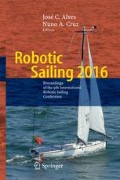Abstract
We are designing a cheap, mass producible 1 m semi-autonomous robotic sailboat that can navigate the oceans for months using only intermittent external supervision. The boat should efficiently collect environmental data such as salinity, turbidity, fluorescence, and animal sounds. The boat has a symmetric airfoil sail, a thin, bulbed keel, and most notably, an apparently new means of steering: a tail-vane rudder replacing the water rudder. The tail-vane rudder is to the main sail as an elevator is to the wing on an airplane, controlling both the angle-of-attack of the wing and the vehicle orientation. The angle-of-attack of the main wing is set by the tail-vane rudder, and the direction of the boat relative to the wind is set by the mast-rotation motor; the tail-vane rudder turns the boat. 2D and 3D dynamic simulations indicate that the tail-vane rudder design yields both (1) a stable wing angle-of-attack (like other wing-sail boats with hinged main sails); and also (2) boat directional stability relative to the wind (like boats with auto-steer wind-vanes). With fixed control-surface angles, the boat finds and maintains a stable heading, regardless of initial conditions. This directional stability allows the boat to operate intermittently with neither electrical power nor a complex wind-vane, thus reducing demands on batteries and solar cells. Tests show that in light winds the boat can sail stably within approximately \(\pm 45^{\circ }\) of the wind direction. Because of the air tail-vane-, instead of water-, rudder, the boat requires new tacking techniques which we are currently developing. As predicted by 3D simulations, experiments show that in heavy winds the boat has an oscillatory instability. It then finds a stable backwards sailing mode. We have yet-untested ideas for correcting this high-wind instability.
Access this chapter
Tax calculation will be finalised at checkout
Purchases are for personal use only
References
Saildrone Web Site. http://www.saildrone.com/
Waveglider Web Site. http://liquidr.com/
Seaglider. http://www.apl.washington.edu/projects/seaglider/summary.html
Udaya Shankar, N.: Reminiscing Rad. J. Astrophys. Astron. 32 615 (2011). (Obituary of CV Radhakrishnan, see figure 4 on page 619 for picture of Radhakrishnan’s wing-sail boat Eldemer in 2005)
Wingsail History—A Brief History of Wingsail Technology and its Commercial Applications. Wing Sails. http://www.solarnavigator.net/wing_sails.htm
Pando, J.: The Nacra Wingsail Project (2013). http://mywingsail.blogspot.com/
Harbor Wing Technologies Website. http://www.harborwingtech.com/index.htm
Elkaim, G.H.: Autonomous surface vehicle free-rotating wingsail section design and configuration analysis. J. Aircr. 45(6), 1835–1852 (2008)
Worsley, P.: Peter Worsley—Wingsail Experiments—Article. http://www.sailwings.net/article.html
Windvane Self Steering Gear for Sailboats. Sailboat-Cruising.com. (2016). http://www.sailboat-cruising.com/self-steering-gear.html
Sakurai, A., Nakamura, T., Nakamoto, Y.: Experimental Study of a Directionally Stable Sailing Vehicle With a Free-Raking Rig and a Self-Trimming Sail. The 16th Chesapeake Sailing Yacht Symposium (2003)
Lanchester, F.W.: Aerodonetics: Constituting the Second Volume of a Complete Work on Aerial Flight. Van Nostrand (1909)
Miller, J.: A Directionally Stable Robotic Sailboat: Concept and Simulations, M-Eng thesis, Mechanical Engineering, Cornell University, April 2016. (preparation for the the Journal of Sailboat Technology)
Mystic Seaport Museum (2016) Luja Line Plans
Author information
Authors and Affiliations
Corresponding author
Editor information
Editors and Affiliations
Rights and permissions
Copyright information
© 2017 Springer International Publishing AG
About this paper
Cite this paper
Augenstein, T., Singh, A., Miller, J., Pomerenk, A., Dean, A., Ruina, A. (2017). Using a Controlled Sail and Tail to Steer an Autonomous Sailboat. In: Alves, J., Cruz, N. (eds) Robotic Sailing 2016. WRSC/IRSC 2016. Springer, Cham. https://doi.org/10.1007/978-3-319-45453-5_8
Download citation
DOI: https://doi.org/10.1007/978-3-319-45453-5_8
Published:
Publisher Name: Springer, Cham
Print ISBN: 978-3-319-45452-8
Online ISBN: 978-3-319-45453-5
eBook Packages: EngineeringEngineering (R0)

